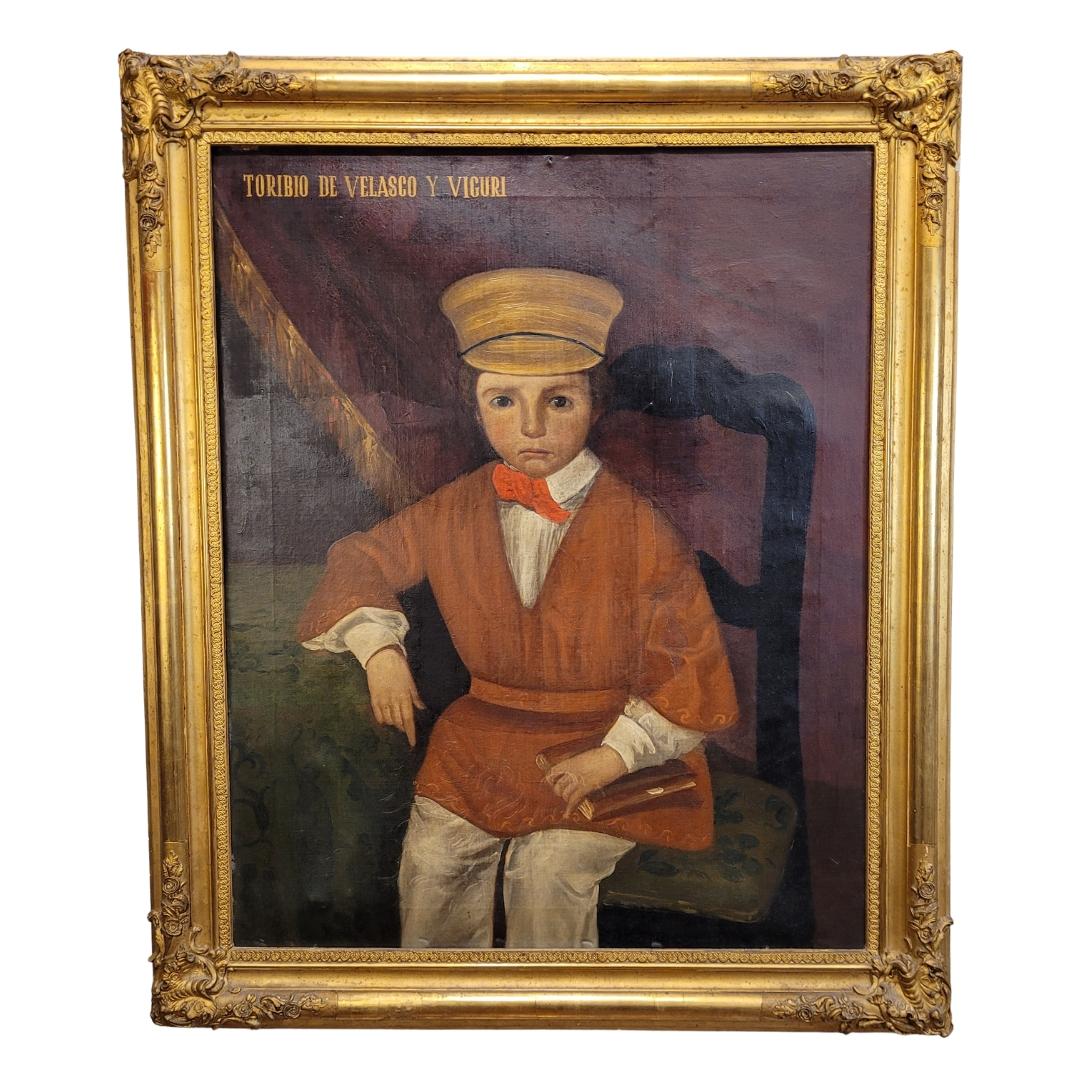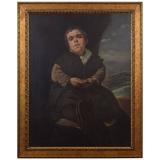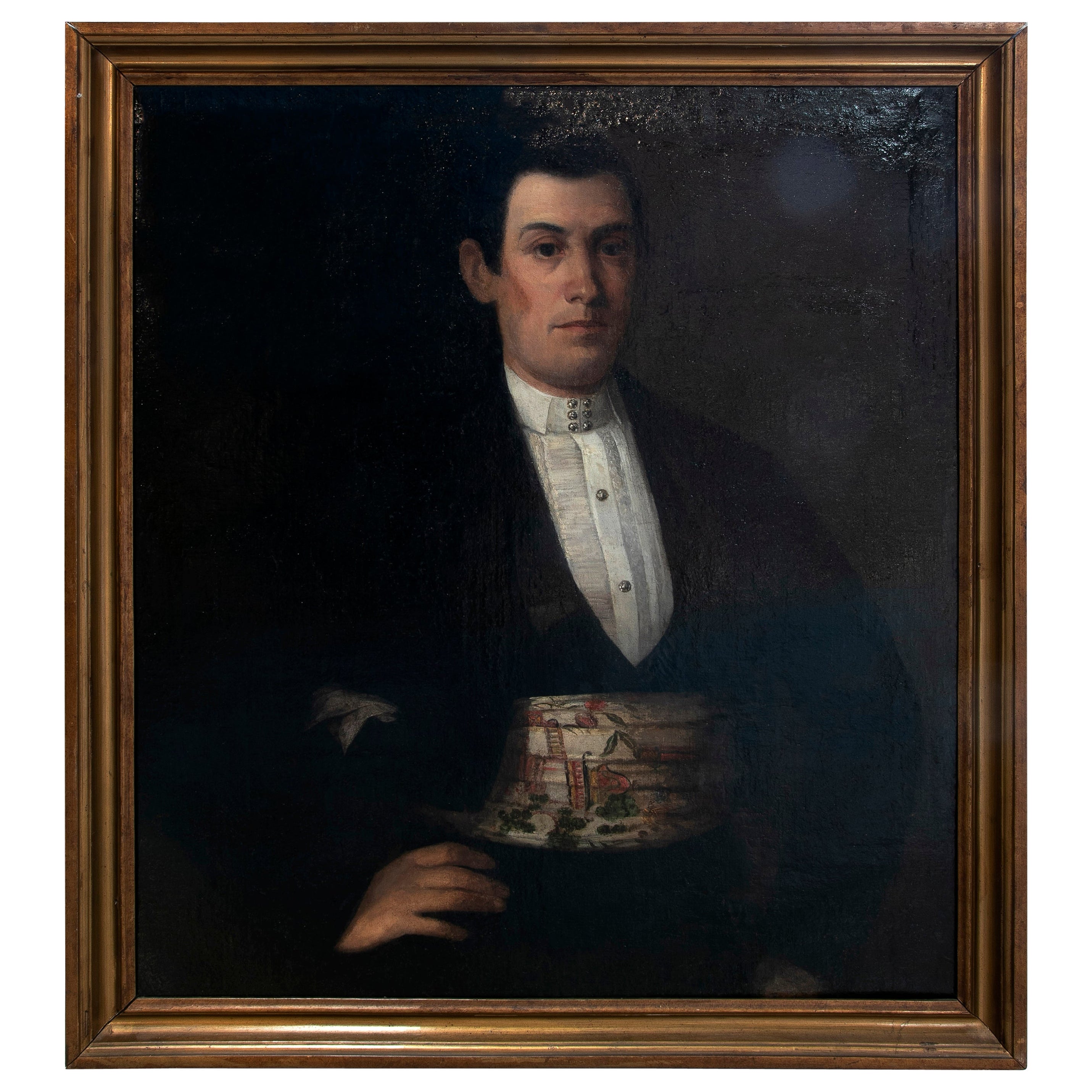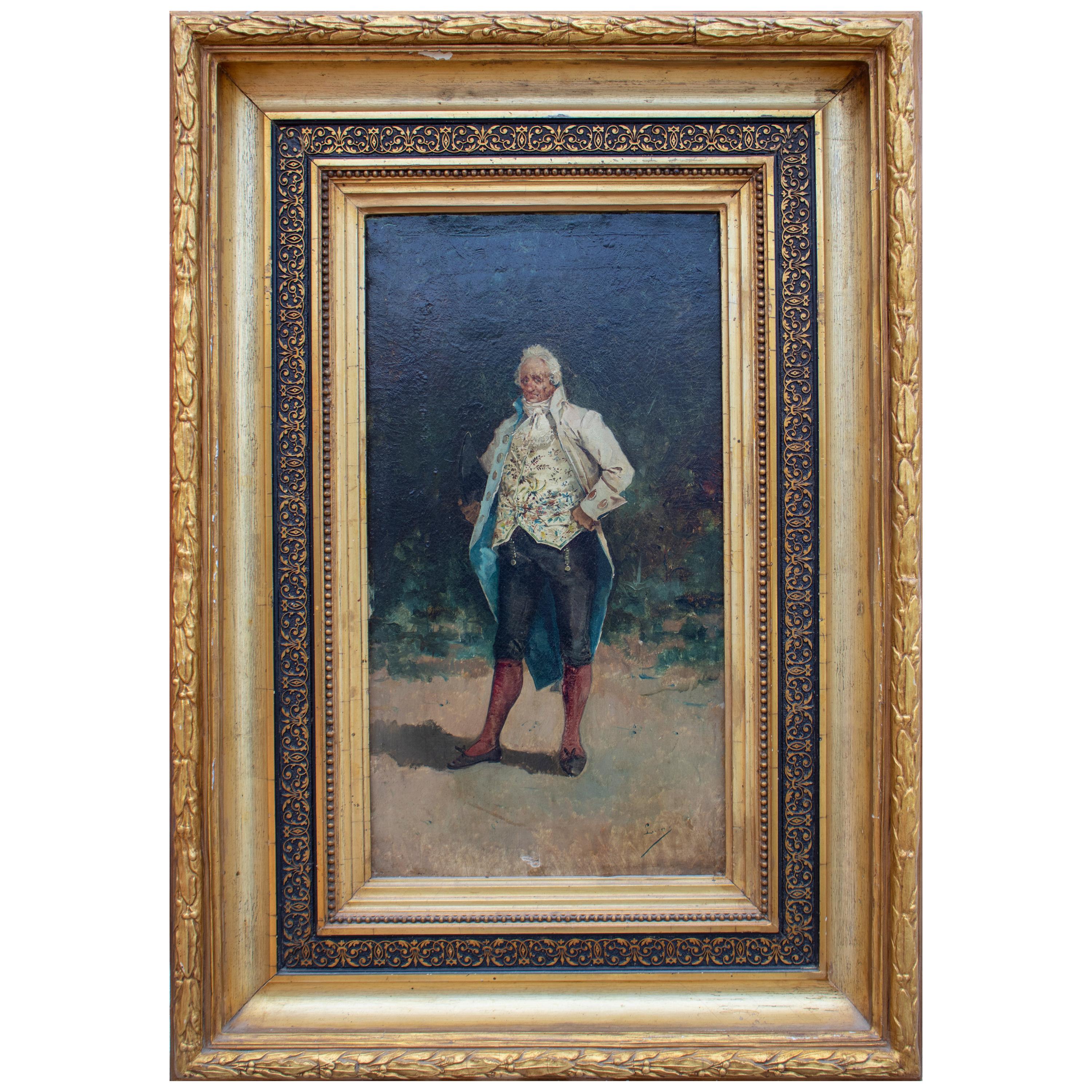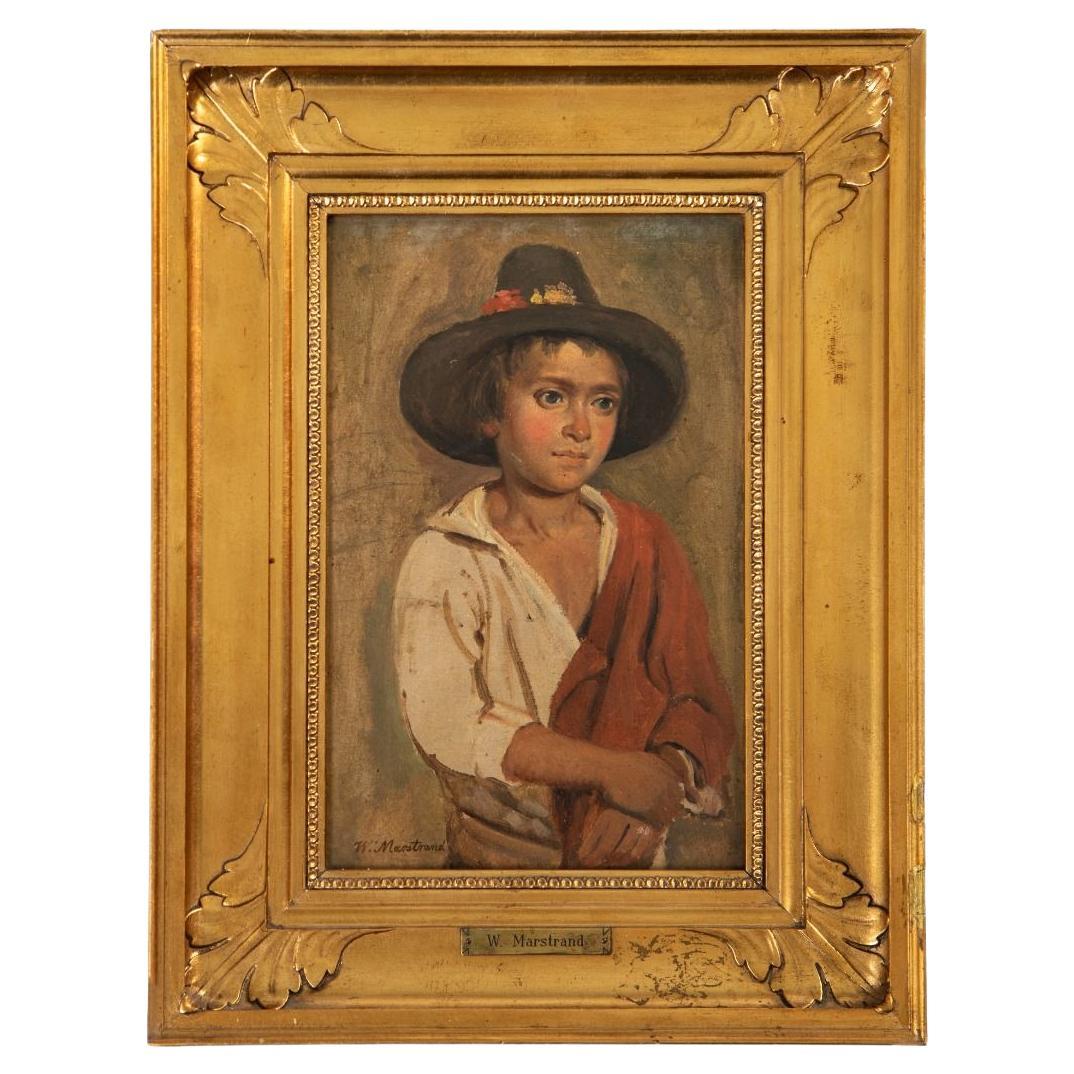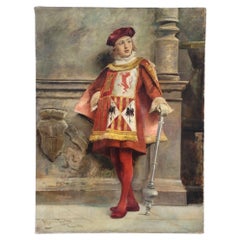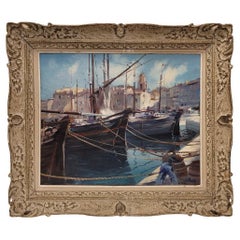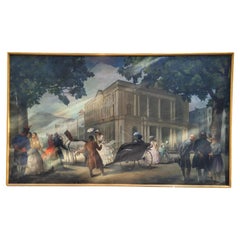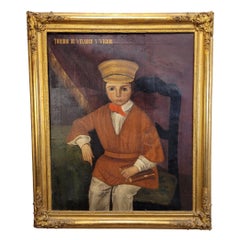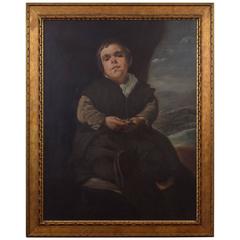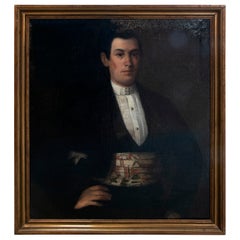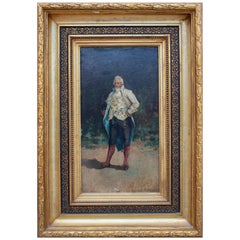Items Similar to Oil on canvas Spanish “Portrait Toribio of Velasco and Viguri”
Video Loading
Want more images or videos?
Request additional images or videos from the seller
1 of 22
Oil on canvas Spanish “Portrait Toribio of Velasco and Viguri”
$5,893.34
£4,464.34
€5,060
CA$8,164.43
A$9,156.95
CHF 4,795.35
MX$111,265.88
NOK 60,892.95
SEK 57,730.81
DKK 38,525.66
About the Item
Outstanding oil on canvas portrait depicting a child, Toribio de Velasco y Viguri, whose name appears written in gold letters in the upper right corner against the dark background of the canvas, a very common practice in the 19th century. In fact, it is possible to date it specifically between 1830 and 1860, due to the use of the kepi-style hat (popular after the Napoleonic Wars) and the tendency to portray children with adult seriousness.
The child is shown seated, with a formal pose and a serious or even melancholic expression on his face. The elements depicted, such as his clothing, hat, and the book he is holding, indicate his high social status. His attire, a jacket and trousers ensemble with a white shirt and an orange bow around his neck, including the kepi-style hat, follows the mid-19th-century fashion, inspired by European-influenced children's school or military uniforms.
In his right hand, he holds what appears to be a book or notebook, which could suggest his education or intellectual interest. The background is composed of a diagonal drapery fabric in dark, reddish tones, which adds an element of depth and drama to the scene. The armchair where he sits has a green cushion with floral decoration, reinforcing the sitter's bourgeois or aristocratic character. The light reflects off the hat, illuminating his face.
Most striking is the child's expression, which conveys a complex mix of restrained emotions. Everything about his expression suggests that the boy has been trained to pose seriously, perhaps as a way of representing maturity or responsibility at a young age, something common in portraits of aristocratic or bourgeois families of the 19th century. Is he tired of posing? Is he simply obeying? Or does he feel profound sadness? This ambiguity in his expression is precisely what gives the portrait such a powerful psychological force.
Also notable is the exceptional gilt frame with carved floral decoration in the corners, in a classical style. It suggests that the painting was considered valuable and prominently displayed.
The subject, Toribio de Velasco y Viguri, who died in 1855, belonged to the Velasco family, famous in the region for their properties and artistic heritage. This painting comes from the Álava-Velasco Palace in Vitoria, which the family inherited.
About the Álava-Velasco Palace in Vitoria-Gasteiz
The Álava-Velasco Palace, located in Vitoria-Gasteiz (Álava), and also known as the Palace of the Marquises of Alameda, is a stately home whose main and rear facades face the Plaza de Santo Domingo and a fenced garden. It is an elegant and luxurious building with a rectangular floor plan, a ground floor, a basement, two floors, and a loft beneath the roof. The most notable feature is the main façade, which is horizontally compartmentalized by impost lines that divide the facade into three floors.
It was commissioned in the late 17th century by Francisco Carlos de Álava-Arista and later inherited by the Velasco family. Records confirm that the Velasco-Viguri family owned the palace until the mid-19th century.
Technical details
Support technique: Oil on canvas
Title of the work: “Portrait of Toribio de Velasco y Viguri”
Genre: Portrait
Period: 1830–1860
Country of origin: Spain
Provenance: Álava-Velasco Palace, Vitoria
Good condition commensurate with age and use
Overall dimensions: 96 x 81 x 4 cm
Unframed dimensions: 80 x 64 cm
- Creator:Spanish Manufactory (Artist)
- Dimensions:Height: 37.8 in (96 cm)Width: 31.89 in (81 cm)Depth: 1.58 in (4 cm)
- Style:Romantic (Of the Period)
- Materials and Techniques:
- Place of Origin:
- Period:
- Date of Manufacture:1850
- Condition:Wear consistent with age and use.
- Seller Location:Valladolid, ES
- Reference Number:1stDibs: LU2943345723422
About the Seller
4.7
Gold Seller
Premium sellers maintaining a 4.3+ rating and 24-hour response times
Established in 1990
1stDibs seller since 2017
159 sales on 1stDibs
Typical response time: <1 hour
- ShippingRetrieving quote...Shipping from: VALLADOLID, Spain
- Return Policy
Authenticity Guarantee
In the unlikely event there’s an issue with an item’s authenticity, contact us within 1 year for a full refund. DetailsMoney-Back Guarantee
If your item is not as described, is damaged in transit, or does not arrive, contact us within 7 days for a full refund. Details24-Hour Cancellation
You have a 24-hour grace period in which to reconsider your purchase, with no questions asked.Vetted Professional Sellers
Our world-class sellers must adhere to strict standards for service and quality, maintaining the integrity of our listings.Price-Match Guarantee
If you find that a seller listed the same item for a lower price elsewhere, we’ll match it.Trusted Global Delivery
Our best-in-class carrier network provides specialized shipping options worldwide, including custom delivery.More From This Seller
View AllFrance Oil on panel “Marina”, French School
By French House & Garden
Located in Valladolid, ES
Exceptional painting depicting a Mediterranean seascape. The two fishing boats in the center of the composition stand out. In the far distance, a village with a small harbor, charact...
Category
Antique Early 1900s French Beaux Arts Paintings
Materials
Wood, Giltwood, Paint
Spanish Painting Portrait“Castilian Macebearer”José Alcázar Tejedor Roma school
By Italian school XX ct.
Located in Valladolid, ES
One of a kind and very Excellent oil on canvas, signed, dated 1880 and located in Rome, work of José Alcázar Tejedor. It represents a mace-bearer, the absolute protagonist of the sce...
Category
Antique 1880s Spanish Beaux Arts Paintings
Materials
Canvas, Wood, Paint
$6,988 Sale Price
27% Off
Gabriel Deschamps French Oil on canvas “Saint Tropez”
By Gabriel Deschamps
Located in Valladolid, ES
Technique on stand: Oil on board
Title of the work: "Saint Tropez"
Author: Gabriel Dechamps (1919 – 2011)
Signed in the lower right corner
Period: Se...
Category
Vintage 1970s French Mid-Century Modern Paintings
Materials
Wood, Paint
$2,655 Sale Price
52% Off
Catalan School Large Painting "The Walk" Oil on canvas , Romantic style
By Mary Spain
Located in Valladolid, ES
“The walk”, Lluís Muntané Muns, Catalan School, pp. 20th century - Spain
Technique on support: oil on canvas
Title of the work: “The Walk”
Author: Lluís Muntané Muns (1899 - 1987)
Style/School: Catalan School
Period: first half of the 20th century
Country of origin: Catalonia, Spain
Origin: Banco Santander
Some damage visible in the photographs and that could be restored
Dimensions: 204 x 343 cm.
One of a kind and Large oil on canvas signed by Lluís Muntané Muns depicting a pleasant everyday scene, aristocrats and bourgeois taking a walk along a wide avenue. The ladies with their elegant dresses and parasols and the men with long coats.
This work is unique, not only for its pictorial quality in such a large, almost muralist size, but for its traceability, it was commissioned at the beginning of the 20th century and includes a bank building from the end and beginning of the 20th century in Latin America.
The composition is divided into a horizontal strip in the lower half in which the different characters are arranged, conversing with each other, flanked by the trees that appear at the ends. Behind them, in the center of the composition rises a large neoclassical-style building that escapes towards the landscape that can be seen in the background.
Lluís Muntané Muns opted for a realistic academicism, of high quality but with sober and static expression, which is also reminiscent of some of the characteristics of Catalan noucentisme. Although most of his career was dedicated to portraits, he also cultivated muralism. A lover of chiaroscuro, he managed to provide warmth to his plastic environments with an equally elegant and contained palette. His compositions are always well constructed and have the elegance that seems a dominant note in all aspects of his work.
Noucentisme or Novencentism designates a cultural movement that began in 1906 in Catalonia (propounded by Eugenio d'Ors), claiming the need for a classicism with a sense of modernity, but that was at the same time linked to tradition, given its nationalist mood. . Catalan identity linked to the classic substratum of Catalonia and its connection with the Mediterranean. He wanted to break with the cosmopolitan character of Modernism and the transience of Impressionism. He set out to achieve a more objective, constant and, ultimately, eternal art. For this, the idea of the “classical” (but never an explicit copy of said period) and the “Mediterranean” was used and the way to capture it in painting was through static, balanced, and simple compositions. It must be pointed out that it cannot be understood as a style, but as a series of ideas that each artist understands in his own way.
In this case, the memory of noucentisme is appreciated above all in the composition: a feeling of serenity, proportion, the figures do not present very exaggerated or grandiose movements... It attempts to represent the eternal through compositional balance. The colors seem muted because this effect was sought, since they understood classicism as something serene and balanced.
Lluís Muntané Muns (Mataró, Barcelona, 1899 – Barcelona, 1987)
A disciple of Vicente Borrás and José...
Category
Vintage 1920s Spanish Romantic Paintings
Materials
Canvas, Paint, Wood
$4,379 Sale Price
35% Off
Belgian Painting Allegoric signed by P. Swyncop
By Philip Swyncop
Located in Valladolid, ES
Ó/L “Peace and the arts are worth more than the brutal glory of weapons”, Philippe Swyncop, 1903 – Belgium, Flemish School
Exquisite oil on canvas si...
Category
Antique Early 1900s Belgian Art Nouveau Paintings
Materials
Canvas, Paint
$10,062 Sale Price
20% Off
French Noble portrait Graphite drawing with carved gilded wood frame
Located in Valladolid, ES
Outstanding French Noble portrait with carved frame, graphite drawing, ff. XIX, pp. XX
Technical data
Drawing on paper
Title of the work: Untitled
Author: anonymous
Portrait paintin...
Category
Vintage 1940s Drawings
Materials
Wood
$782 Sale Price
20% Off
You May Also Like
Oil on canvas Spanish “Portrait Toribio of Velasco and Viguri”
Located in Valladolid, ES
Outstanding oil on canvas portrait depicting a child, Toribio de Velasco y Viguri, whose name appears written in gold letters in the upper right corner against the dark background of...
Category
1850s Romantic Portrait Paintings
Materials
Canvas
Oil on Canvas, after Diego Rodriguez de Silva y Velazquez, Early 20th Century
Located in Atlanta, GA
Painted after the original work titled, The Dwarf Francisco Lezcano, Called "El Nino de Vallecas", 1643-1645, in an early 20th century giltwood frame, previous...
Category
20th Century Paintings
Early 19th Century Spanish Andalusian Oil on Canvas Portrait Painting
Located in Marbella, ES
Antique early 19th century Spanish Andalusian oil on canvas portrait painting.
Dimensions with frame: 94x81x4cm.
Category
Antique Early 19th Century Spanish Paintings
Materials
Canvas
19th Century Oil on Canvas Portrait by Eugenio Lucas
Located in Marbella, ES
19th century oil on canvas portrait by Eugenio Lucas.
Dimensions with frame: 67 x 47.5 x 7.5cm.
Category
Antique Mid-18th Century Spanish Paintings
Materials
Canvas
Early 19th Century, Georgian Portrait Painting, Oil on Board, C.1820s
Located in London, GB
For sale a charming European late 18th, early 19th Century Georgian/Regency era oil on board portrait painting of a youthful person, possibly a scholar, believed to have been painted...
Category
Antique Early 18th Century European Biedermeier Paintings
Materials
Gesso, Wood, Giltwood
Portrait Of Italian Boy By Wilhelm Marstrand Oil On Wood
By Wilhelm Marstrand
Located in Kastrup, DK
Small portrait of an Italian boy with a hat and a red jacket.
Oil on canvas. Dimensions: 21 x 14.5 cm.
Signed: W. Marstrand.
Probably painted around 1840, framed in a contemporary gi...
Category
Antique Mid-19th Century Danish Romantic Paintings
Materials
Brass
More Ways To Browse
Hand Carved Santos
Military Shirt
Dior Bow Jacket
Windmill Plate
Wolf Carved
17th Antique Clock
1876 American Flag
1920s Bureau
24k Gold Cup
Abhaya Mudra Sculpture
Ancient Weapon
Angel Plaques
Antique Bay Window
Antique Biscuit Table
Antique Brick Mold
Antique Carousel Horse
Antique Cloisonne Animals
Antique Empire Secretary Desk
